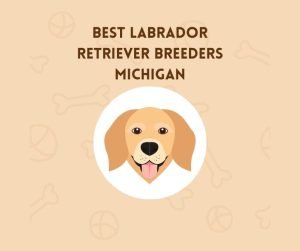Are you finding a companion for your Labrador Retriever? This article talks about best companion dogs for Labs. I’m sure it will help you find the right canine for your Lab.

The Labrador Retriever is the most popular dog breed in the U.S. and across the globe. From 1991, it ranks 1st in AKC’s “Most Popular Dog Breeds” list.
Friendly, fun-loving, and affectionate personality traits make Labradors most popular breed. They get along well with everyone, including family members, kids, other dogs, and even strangers.
Quick links to different sections
ToggleLabrador Retriever: History
From the name, it may seem that this breed originated from Labrador, Canada. In reality, Labrador originated in Newfoundland, Canada.
The modern labrador came from St. John’s dog. In the past, the breed was known by the names – St. John’s water dog and Lesser Newfoundland.
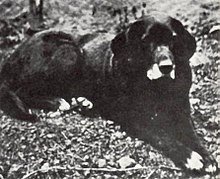
The modern Labrador Retriever’s ancestor – St. John’s water dog was known for its ability to help fishermen catch fish. Later on, during the 19th and 20th centuries, these dogs were exported from Newfoundland to England.
Newfoundland dog breed is also believed to have originated in Newfoundland. ‘Labrador Retriever’ name was given by the British breeders to avoid name confusions between both breeds.
Breeders turned this fish retriever, water dog into a hunting dog. The Labrador was bred to be a good family companion as well as a working dog.
At present, it is one of the favorite dog breeds for families as well as hunters. Due to their friendly nature, families adopt Labs for affection and companionship. On the other hand, a soft mouth and retrieve drive make Labrador a perfect hunting dog.
Do Labradors Get Along With Other Dogs?
The answer is YES. Labradors are sociable dogs. They can get along with other dogs, other pets, and kids. With early socialization and puppy training classes, your Lab can get along with almost anyone.
In some cases, even a well-bred dog breed like Labrador may not get along with other dogs. That’s because temperament and personality vary from one dog to another.
Do Labradors Need Another Dog?
One of the main characteristics which make Labrador an amazing family dog is their lovable, affectionate nature.
“Should I get another dog?”
At some point, this question comes to the minds of dog owners.
The most common situation dog owners introduce a new dog is when their existing Labrador isn’t getting proper socialization and becoming lonely.
With a new dog, both of them can enjoy each other’s company. Getting a new dog can be a good idea when you spend the majority of your time outside and leave your Lab alone for long hours.
But, before adopting, you need to consider how it will affect you and your family members. As a responsible owner, you have to provide attention to both dogs and take care of their grooming needs, exercise needs, training, food, and more.
Best Companion Dogs For Labs
If you have decided to get a new dog, you must be wondering “Which is the best breed for Labrador?” Well, here’s the list of the 15 best dog breeds that are compatible with labrador retrievers:
- Labrador Retriever (getting a second Lab)
- Airedale Terrier
- Beagle
- Golden Retriever
- Boston Terrier
- American Cocker Spaniel
- Bouvier des Flandres
- English Springer Spaniel
- French Bulldog
- German Shepherd
- Greyhound
- Saluki
- Pug
- Kerry Blue Terrier
- Border Collie
Labrador Retriever
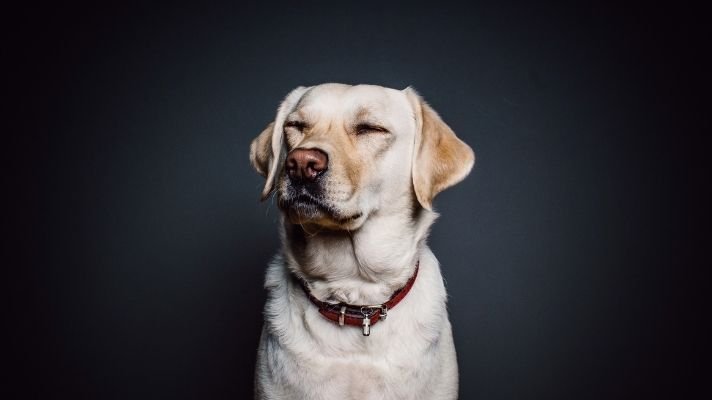
A new Labrador is the best companion you can get for your existing Labrador. The reason is both have similar mindsets and understand each other well.
As both will have the same training, grooming, exercise, and other requirements, you do not have to manage both of them separately. With the two different dog breeds, there will be certain needs you have to perform separately for both the dogs.
However, in some instances, jealousy can be a problem when two Labs are together. A Lab can be a bit jealous when it feels that another Lab is getting more attention. The best way to deal with it is to make sure that both the Labradors get equal attention.
The problem of jealousy and fighting is more likely to occur when there are two female Labradors together, and not two male or male-female Labradors.
BREED OVERVIEW
Origin: Newfoundland, Canada
Colors: Black, Chocolate, Yellow
Height: Male: 22.5-24.5 inches, Female: 21.5-23.5 inches
Weight: Male: 65-80 pounds, Female: 55-70 pounds
Life Expectancy: 10-12 years
Airedale Terrier
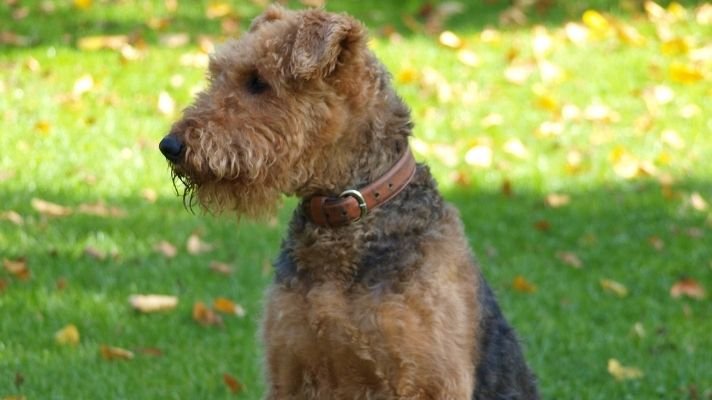
Airedale Terrier is the largest of all terrier breeds and it is known as ‘The King of Terriers’.
We have seen that a pair of two Labs can create the problem of jealousy (especially two female Labs). However, by pairing your Labrador with Airedale Terrier, there would be rare chances of jealously. That’s because both breeds have different attention requirements.
Talking about grooming, Airedales have a short coat with lesser grooming requirements. Brushing once a week would be enough to maintain their coat health.
BREED OVERVIEW
Origin: England
Colors: Tan & Black, Tan & Grizzle
Height: 23 inches approx.
Weight: 50-70 pounds
Life Expectancy: 11-14 years
Beagle

Beagle is one of the most popular dog breeds in the United States. It was developed mainly for beagling. The modern Beagle was developed in the 1830s in the UK.
The breed is active and fun-loving. Beagles are perfect companions for families with children. By getting a Beagle dog, you would be pairing two family-friendly dogs together.
As Labradors and Beagles are active and bred primarily for hunting, they love being involved in outdoor activities.
BREED OVERVIEW
Origin: England
Colors: Lemon & White, Black & Tan, Black Red & White, Black Tan & Bluetick, Black Tan & White, Brown & White, Brown White & Tan, Red & White, Tan & White, Blue Tan & White
Height: Male: 14-16 inches, Female: 13-15 inches
Weight: Male: 22-24 pounds, Female: 20-22 pounds
Life Expectancy: 10-15 years
Golden Retriever

Golden Retriever can also be the best companion dog for Labrador. It is the second most popular dog breed in the U.S.
Pairing a Labrador with a Golden Retriever can be a good idea because both breeds have a lot in common. Both are retriever dogs bred for hunting.
Like labs, Goldens are also outgoing, active, energetic, fun-loving, intelligent, and easy to train. With early socialization and proper training, both dogs can get along really well.
BREED OVERVIEW
Origin: Scottish Highlands
Colors: Cream, Golden, Light Golden, Dark Golden
Height: Male: 23-24 inches, Female: 21.5-22.5 inches
Weight: Male: 65-75 pounds, Female: 55-65 pounds kg
Life Expectancy: 10-12 years
Boston Terrier

Boston Terrier was originally bred to be a fighting dog. Modern Bostons are gentle, affectionate, and lively. The playful personality of Boston Terrier makes it an ideal companion for Labs.
The physical needs of Bostons are quite less as compared to Labs. However, it does vary from one dog to another.
If you are a family with children, note that this terrier breed doesn’t like to be mishandled. After getting a Boston, make sure to train your kids how to handle pets.
BREED OVERVIEW
Origin: United States
Colors: Black & White, Brindle & White, Black Brindle & White, Seal & White, Seal Brindle & White
Height: 15-17 inches
Weight: 12-25 pounds
Life Expectancy: 11-13 years
American Cocker Spaniel
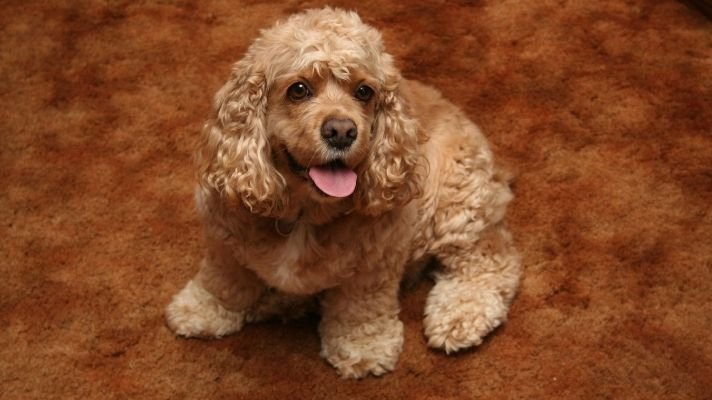
The American Cocker Spaniel is a sporting dog breed with fun and affectionate temperaments. Because of its fun-loving and playful personality, it can be a good companion for a Labrador.
Grooming is the main concern with American Cocker Spaniels. The breed has silky, double coats that require a lot of grooming.
As this is a sporting breed, it is energetic and active. Hence, to utilize Cocker Spaniel’s excess energy the right way, it’s important to provide enough exercise on a regular basis.
BREED OVERVIEW
Origin: United States
Colors: Black, Tri-color, Tan, White & Buff, Brown, Red, Silver
Height: Male: 14.5-15.5 inches, Female: 13.5-14.5 inches
Weight: Male: 25-30 pounds, Female: 20-25 pounds
Life Expectancy: 10-14 years
Bouvier des Flandres
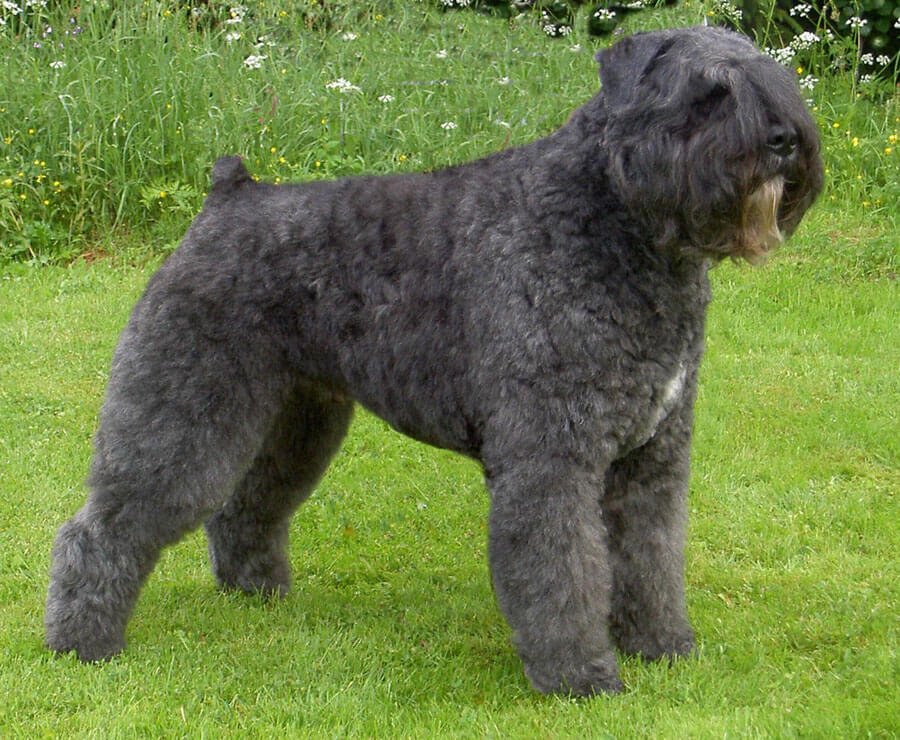
Bouvier des Flandres dogs are calm, affectionate, loyal, and protective. The Bouvier was originally bred to be a farm dog. They were used by farmers for various tasks like pulling carts, herding livestock, cattle driving, etc. Nowadays, Bouviers are used as guard dogs.
Their calm and loving personality makes them ideal for Labs. To make your Lab dog and Bouvier get along well, early socializing and training play a significant role. When you introduce your Lab to Bouvier when it’s fully grown, it might be aggressive.
As Bouviers are bred to perform various physical activities, it has higher energy levels and exercise needs. If your lifestyle isn’t active, Bouvier may not be right for you.
BREED OVERVIEW
Origin: Belgium (Flanders), France
Colors: Black, Brindle, Fawn, Gray, Gray Brindle, Pepper & Salt
Height: Male: 24.5-27.5 inches, Female: 23.5-26.5 inches
Weight: 70-110 pounds
Life Expectancy: 10-12 years
English Springer Spaniel
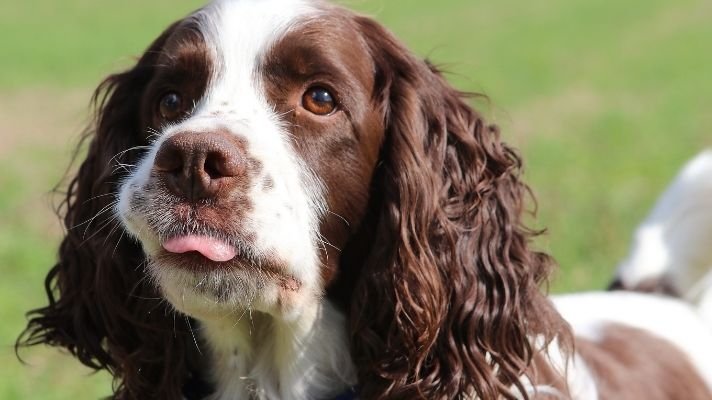
The English Springer Spaniel is a dog breed of the Spaniel family. In the past, the breed was used for flushing and retrieving games.
By comparing English Springer Spaniel with the Labrador, you will notice that certain temperaments are very similar. Firstly, both are affectionate dogs. They get along well with families, kids, other dogs, and strangers as well.
Besides this, English Springer Spaniels are also energetic and have higher exercise needs. Daily outdoor activities and play sessions are necessary to burn off the excess energy.
BREED OVERVIEW
Origin: England
Colors: Black & White, Black White & Tan, Liver & White, Liver White & Tan, White & Black, White & Liver, Lemon & White, Orange & White, Red & White
Height: Male: 20 inches approx., Female: 19 inches approx.
Weight: Male: 50 pounds approx., Female: 40 pounds approx.
Life Expectancy: 12-14 years
French Bulldog

French Bulldog is another breed that can be a great companion for your Labrador as well as your family. It is the cross between Toy Bulldogs and local ratters.
After Labrador, this is another most popular dog breed as per AKC’s rankings. The breed got so much attention due to its sociable, playful, and affectionate temperaments.
When it comes to training, Frenchies can be stubborn, however, they are also eager to please. Thus, with the motivation-based training methods, a Frenchie can be easy to train.
BREED OVERVIEW
Origin: France
Colors: Brindle, Brindle & White, Cream, Fawn, Fawn & White, Fawn Brindle, White, White & Brindle, White & Fawn
Height: 11-13 inches
Weight: under 28 pounds
Life Expectancy: 10-12 years
German Shepherd

According to AKC, the German Shepherd ranks number third for the title “2020 Most Popular Dog Breeds”(after Labrador and French Bulldog). As the name suggests, the breed originated in Germany.
If you are looking for amazing temperaments like intelligence, affection, strength, trainability, and obedience in one dog, a German Shepherd can be a good choice.
Both Labs and Germans have many traits in common. A German Shepherd can be a good companion and get along well with your existing Lab. However, early socializing and proper behavior training are so important.
BREED OVERVIEW
Origin: Germany
Colors: Black, Black & Cream, Black & Red, Black & Silver, Black & Tan, Blue, Gray, Liver, Sable, White, Bi-color
Height: Male: 24-26 inches, Female: 22-24 inches
Weight: Male: 65-90 pounds, Female: 50-70 pounds
Life Expectancy: 7-10 years
Also Read: Labrador Retriever & German Shepherd Mix
Greyhound

Primarily, Greyhounds were bred to chase foxes, hare, and deer. Do you know the Greyhound can reach a full speed of 70kmph (43mph)? The breed is popular as a racing dog. It is known to be the fastest dog breed.
Greyhounds are affectionate as well as energetic. Because of similar temperaments, your Lab will not have difficulty getting along with a Greyhound dog.
To start seeing results faster, make sure to use the right training approach. This dog breed can get bored easily. Try keeping training sessions short so that the Greyhound doesn’t get bored.
BREED OVERVIEW
Origin: Europe
Colors: Black, Blue Fawn, Blue, Blue Brindle, Red, Red Brindle, White, White & Black, White & Red, Black Brindle, White & Blue, White & Black Brindle, White & Blue Brindle, White & Blue Fawn, White & Red Brindle
Height: Male: 28-30 inches, Female: 27-28 inches
Weight: Male: 65-70 pounds, Female: 60-65 pounds
Life Expectancy: 10-13 years
Saluki

Saluki is one of the oldest dog breeds. A Saluki can be a good companion dog for your Labrador when trained properly. Training is required because the breed has a high prey drive. Due to its stubborn nature, it can be quite difficult to train.
Salukis are energetic, hence their exercise needs are also quite high. In the absence of enough regular exercise, the breed can be destructive.
Talking about grooming, grooming a Saluki would be easy. The main grooming requirement for the Saluki is weekly brushing. The breed is very clean, hence bathing is required only when the Saluki gets dirty.
BREED OVERVIEW
Origin: Fertile Crescent
Colors: Black, Black & Silver, Black & Tan, Black Tan & White, Chocolate, Chocolate & Tan, Cream, Fawn, Golden, Red, Silver, White
Height: 23-28 inches
Weight: 40-65 pounds
Life Expectancy: 10-17 years
Pug
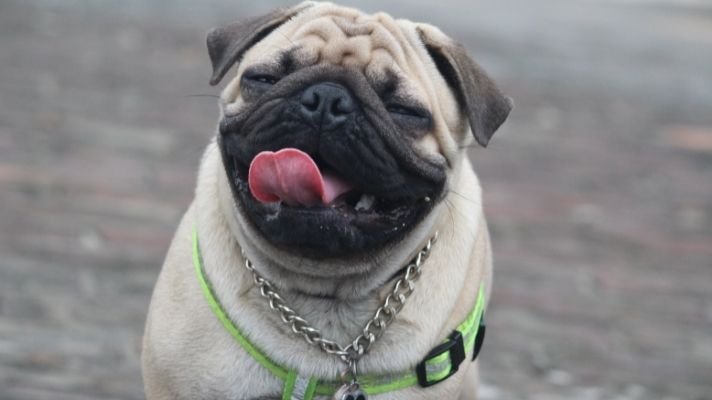
Pugs are loving and happy dogs. Due to their fun nature, they are also known as the clowns of the canine world. As Labs and Pugs both are affectionate, they can be good companions.
The dog breed has a short and glossy coat that sheds a lot. However, the grooming needs are minimal.
A Pug dog can be hard to train when the wrong training methods are being used. With the right training approach, it can be easy to train. Trying harsh training methods can easily hurt the Pug’s feelings.
BREED OVERVIEW
Origin: China
Colors: Black, Fawn
Height: 10-13 inches
Weight: 14-18 pounds
Life Expectancy: 13-15 years
Kerry Blue Terrier
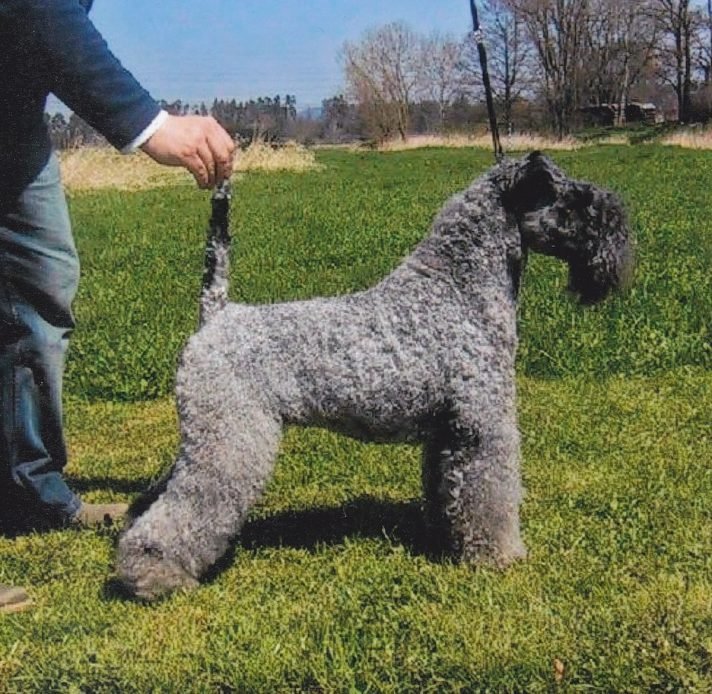
Kerry Blue Terrier or Kerry is a working dog bred originally to control rabbits, rats, and foxes; and to herd sheep & cattle. At present, this dog breed is adopted by families for companionship.
If you are thinking of pairing a Kerry dog with your Lab, it is recommended to introduce & socialize this dog to your existing Lab as early as possible.
The good thing about this dog breed is it sheds little to none. If you or any of your family members are allergic to dog shedding, this can be a good choice. As the breed doesn’t shed, weekly brushing and combing are necessary to avoid matting.
BREED OVERVIEW
Origin: Ireland
Colors: Black, Blue, Blue & Black, Blue & Silver, Blue & Gray, Silver, Silver Blue, Slate Blue, Gray
Height: Male: 18-19.5 inches, Female: 17.5-19 inches
Weight: Male: 26-33 pounds, Female: 22-29 pounds
Life Expectancy: 12-15 years
Border Collie
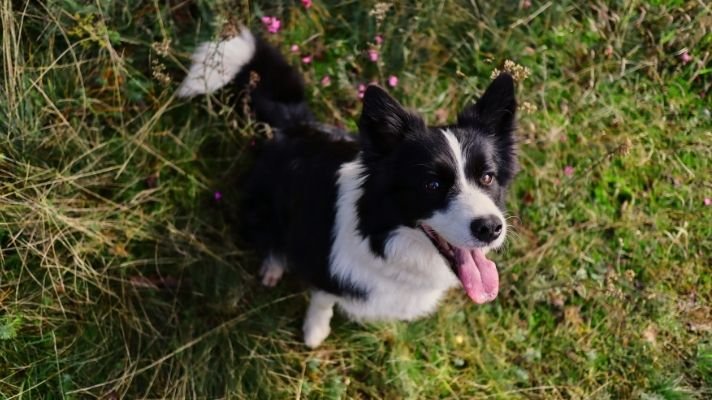
The Border Collie is a highly intelligent dog breed. The breed was originally bred to gather and control sheep. Personality characteristics like higher energy level and affectionate nature make them the best companion for Labradors.
Both breeds are energetic and have higher intelligence levels, hence daily physical activities and mental stimulation are so important.
If you do not have an active lifestyle and do not have enough time to provide physical & mental stimulation, Border Collie and Lab may not be a good combination.
BREED OVERVIEW
Origin: Anglo-Scottish border
Colors: Black, Blue, Blue Merle, Brindle, Gold, Red, Sable, Sable Merle, White & Blue, White & Blue Merle, Lilac, Saddleback Sable, White & Red Merle, White Ticked, White & Gold, Seal, Slate, White & Seal
Height: Male: 19-22 inches, Female: 18-21 inches
Weight: Male: 31-44 pounds, Female: 26-42 pounds
Life Expectancy: 12-15 years
Related Questions
Are labs good with small dogs?
Yes, Labs can get along with small dogs. The good thing about Labs is they are intelligent and easy to train. Thus, you can train them to be good with a small pet.
Should I get another Labrador?
You should get another labrador only if you are ready. By getting a second labrador retriever, there will be double costs and double efforts. Two Labradors can get along really well as both have a similar mindset and they understand each other nicely. A new Lab can be a good companion for your existing Lab, however, you should also consider your lifestyle and daily routine before getting another Labrador Retriever.
Can 2 male Labradors live together?
Yes, two male Labs can live together. In most cases, two male Labradors get along really well.. However, it is also based on the individual personality of the dogs.
Will two female Labradors get along?
Yes, two female Labs can get along well when trained properly. A pair of two female Labradors are more prone to fight and jealousy compared to two male Labradors. When living together, mostly two female Labs fight for food, toys, attention, and territory. However, raising two female Labs from their puppyhood might prevent this issue.
Final Thoughts
The Labrador Retriever is friendly and loving, which makes it ideal for families, children, and other dogs. At some point, you might have felt that your Labrador needs a dog companion. If you think you can take care of two dogs, then you should definitely consider getting a new dog.
As the Labrador is a friendly breed, it will get along really well with a new dog.
Note that pairing your Lab with the wrong breed of dog that doesn’t share similar personality traits can create problems. As long as another dog is also friendly and easygoing, there won’t be a problem.
TRAIN YOUR CANINE! ⬇️
[adinserter block="1"]

